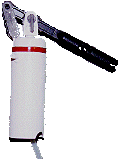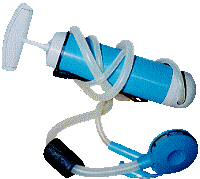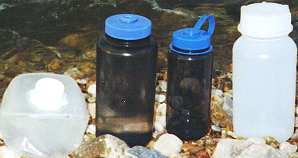Chapter 10
Water and Water Purification
Obtaining
Filters
vs. Purifiers Using
Criteria Comparisons
Vessels Quotations
TRAVELERS MUST INCREASE water intake as they expend more
energy carrying a pack, walking, museum-going, and being outside. In hot climates the
need for water doubles or triples. Hikers require a gallon or more per day as they
sweat and respire water and water vapor. Note that alcohol and caffeinated drinks have a
dehydrating effect.
Thirst is not a reliable
indicator of hydration state. As visible semi-mucous membranes, lips
are. The next time yours feel dry
or chapped drink several
glasses of water and see what happens.1
Another barometer is urine color. If it's always dark you're probably a
liter or two low. A rule of thumb is to drink enough water to ensure at least two clear,
healthy pees per day.
In Western Europe, much of Eastern Europe, and other developed countries you can drink
safely from public water supplies. In many (but not all) developing countries
the water supply contains diarrhea-producing bacteria. While some hard travelers adjust to
impure water over weeks or months, most travelers avoid discomfort by buying most or all
of their water.
Ice cubes in developing countries are
rarely made from purified water; they bite even from alcoholic drinks.
- Buying water
- is usually easy. It is sold in convenient one or 1.5-liter plastic bottles which cost
from fifty cents to $3, depending on the country. Look for a quality label and a
safety-sealed cap. Bottled drinks are also safe and routinely drunk by travelers.
- Boiling
- makes tea, coffee, and soups safe in developing countries. Opinion varies on how much
boiling is necessary, but a minute or two at full boil should do the job.
- Iodine
- is the preferred chemical treatment for water. It is easy and effective in twenty
minutes, but iodine probably should not be used for months at a time. It also should
not be used by pregnant women and people with thyroid conditions. The two most popular
iodine treatments in the U.S. are Potable Aqua and Polar Pure.
-
 Potable Aqua
Potable Aqua
- consists of tiny iodine tablets in a small glass bottle. Directions are one or two
tablets (depending upon temperature, clarity, and Giardia control) per liter of water.
Shake and let dissolve, then loosen the cap and shake again to allow the iodized water to
spread over the threads, killing germs there. It's ready for drinking in twenty minutes.
- The water has a slight brownish-orange color, and a moderate iodine taste. Potable Aqua
also comes with ascorbic acid tablets, called P.A. Pure, which greatly reduce the iodine
taste and off-color.
- Potable Aqua tablets should be left sealed in the glass bottle until use as they have a
limited effective life after exposure to air.
-
 Polar Pure
Polar Pure
- consists of a four-ounce (120 milliliter) glass bottle with crystallized iodine in the
bottom. First, the bottle is filled with several ounces of water, then after a few minutes
(time dependent on water temperature--a small thermometer is attached) this bottle is
poured into a quart of water to be purified. The crystals remain in the original glass
bottle. While Polar Pure is slightly more complicated than Potable Aqua, less iodine is
used, and it has a longer shelf life.
- Liquid iodine
- from a dropper bottle is an alternate method used by some travelers. When faced with
suspect water in a restaurant they add two or three drops per glass of water, stir, and
wait a few minutes. This is unscientific but seems to work.
- Silver
- water disinfectant tablets are expensive at about $20 for a packet of forty tablets,
which purifies forty liters. Silver is an alternative for those who don't want to use
iodine.
- Chlorine
- tablets or liquid are not recommended as a water purifier, as chlorine is unstable and
not always effective. Since it is also associated with a small cancer risk, only use
chlorine in a pinch.
- Filtering
- cleans water mechanically. Special purifying
filters may make sense when camping
away from campgrounds--say in
Central American National Parks, or otherwise in the bush. Travelers in
Africa, Asia, Latin America, and the former Soviet Union could also benefit. In the long
run you could save money by filtering instead of buying, and certainly spare
Earth
from hundreds of unrecycled plastic bottles.
- Boiling is inconvenient since it requires
much time and fuel. While iodine
renders water bacteriologically safe, it doesn't remove crud or improve taste. A good filter pumps
out good water in a few minutes, and provides a real boost
as opposed to drinking boiled or iodine-purified--but
horrible tasting--water.
Filters work by
forcing water through
material of a certain pore size which
screens contaminants. These are fine for backcountry use in the U.S. and Canada since Giardia is the main contaminant here. (Giardia screening requires a pore size of two
microns.) Developing countries, however, may have waterborne viruses, such as hepatitis
and polio, which are 0.04 microns or smaller. Thus virus control requires boiling, iodine
chemical treatment, or a purifying filter.
The PUR filters listed below, as well as the Sweetwater Guardian with its Viralguard
accessory, incorporate iodine matrixes which kill viruses and bacteria without passing much
iodine into the water.
According to a Katadyn white paper that appears scientific to this nonscientist, in
practice non-purifying filters that screen contaminants to 0.2 microns remove most viruses
since viruses usually attach themselves to bigger things, which are then screened. This
apparently hasn't impressed real scientists at the EPA, however, so if using a
non-purifying filter on suspect developing-world water you probably should add iodine
after filtering. While not as much iodine is necessary as with unfiltered water, you still
must wait twenty minutes before drinking.
Avoid fast clogging by always using the cleanest available water. If the water is
particularly dirty or silt-laden, let it settle in a pot before filtering, and/or use a
coffee filter or cloth as a pre-filter. I permanently clogged a not-field-cleanable filter
on the second liter drawn from a silty Washington river.
To clean a clogged filter you must carefully follow manufacturer instructions. A grave
possibility is contaminating yourself with the nasty bacteria trapped inside the filter.
You must also be careful about contamination from the water-source hose. Take care with a
ceramic filter since a hairline crack will make it 100% ineffective.
Selection Criteria for Water Filters
If you will be depending on a filter for much of your water field cleanability, pump
speed, and ease of use are far more important than a few ounces of weight. A good filter
saves you from carrying at least some water, which weighs eight pounds per gallon
(or one kilogram per liter). Pump speed lessens the more the filter is used.
Filters with a pore size of one micron or less are good. Smaller pore sizes and smaller
filters clog faster. Carbon filters trap pesticides and metals, which for my taste is a
worthwhile feature. Ceramic-only filters do not.
For emergency or short periods of developing world backcountry use, filters such as the
PUR Voyageur, PUR Scout, and Sweetwater Guardian with iodine cartridge are good choices.
If you will be filtering mostly from faucets or sinks (the usual scenario), clogging and pump speed will be less of a problem, so smaller filters should
suffice.
If you will be filtering most or all of your water from wells or streams, say in East
Africa or the Darien Gap, then you will appreciate having (and essentially require) an
easy-pumping, easy-cleaning, full-size filter. You may also require spare
cartridges or filtering elements.
A water purifier is not a requirement for developing-world travel. Most
travelers buy most of their water and use iodine tablets or drops in a pinch.
All specifications are from the manufacturers--cartridge capacity will be less if pumping
brackish or silty water, and after a few gallons of use only Superman can pump
as fast as claimed.
- Katadyn Pocket
- $300, 23 oz. (650 g.). Pumps about one liter per minute. Screens to 0.2 microns. This
Swiss product has been widely used for thirty years due to the large and easily cleaned
ceramic element, which lasts up to 13,000 gallons (50,000 liters). Because it takes
considerable power to pump through thick ceramic, the Katadyn Pocket is best for long term
users who may not have access to replacement cartridges, who require high volume and low
per gallon cost, and/or tonier musculature.
-
 Sweetwater Guardian Plus
Sweetwater Guardian Plus
- $70, 15 oz. (425 g.). Pumps about one liter per minute. Carbon filter screens to 0.2
microns. Plus model contains an otherwise optional ($25) iodine matrix
cartridge for virus protection. Field cleanable. Cartridge capacity rated at 200 gallons
(750 liters)--replacements are $30. (Pictured right without hoses or accessories.)
- MSR MiniWorks
- $60, 16 oz. (450 g.). Pumps about 2/3 liter per minute. Ceramic element with a carbon
core that screens to 0.3 microns. While well-regarded like most MSR products and all the
filters listed here, for virus removal MSR recommends pre-treating with iodine. Therefore
this and the larger WaterWorks II are probably better for long term use
if water-borne viruses aren't a worry and iodine is. Field cleanable. Cartridge capacity
rated at 40 cleanings--replacements are $30.
-
- PUR Voyageur
- $70, 11 oz. (310 g.). Pumps about one liter per minute. Screens to 0.3 microns. Travel
version of the popular PUR Hiker that adds virus protection by screening through an iodine
resin glassfiber. While the cartridge is guaranteed not to clog for one year, that's
mainly a calculation that most purchasers will only use the filter for a few
weekends--replacements are $35.
- PUR Scout
- $80, 14 oz. (400 g.). Pumps about one liter per minute. Screens to 0.3 microns, then
passes through an iodine matrix which kills all other bacteria and viruses. Only a little
iodine is absorbed, which can just be detected by taste.
 An
optional (and recommended) carbon cartridge ($15) removes this iodine and many organic
chemicals such as pesticides. Field cleanable. Cartridge capacity rated at 100 gallons
(378.5 liters)--replacements are $40.
An
optional (and recommended) carbon cartridge ($15) removes this iodine and many organic
chemicals such as pesticides. Field cleanable. Cartridge capacity rated at 100 gallons
(378.5 liters)--replacements are $40.
- PUR Explorer
- $130, 20 oz. (565 g.). Screens to 0.3 microns. Larger and better than the Scout, with
faster pumping (about 1.3 liters per minute) and auto-cleaning by twisting the handle.
This is probably the fastest pumping, easiest to clean, and with the optional carbon
cartridge, most effective filter. Cartridge capacity rated at 100 gallons (378.5
liters)--replacements are $45. (Pictured right with 130 micron prefilter.)
- Plastic water bottle
- 1 oz. (28.35 g.), free with purified water or soft-drink purchase. Used by most travel
backpackers and long distance trail hikers, it's several ounces lighter than other
choices, doubles as a pillow, and the screw cap usually works well.
| Left to right: The Cube one liter, Nalgene one liter and half liter, and polyethylene one liter. |
 |
- Nalgene Lexan bottle
- 4 oz. (110 g.), $6. This is a nearly perfect water vessel. It's beautiful (if you scrape
off the advertising); leak proof (due to the stiffness of Lexan); and unlike softer
polyethylene, imparts no taste upon water. The negatives are it weighs four ounces,
costs money, and makes a terrible pillow.
- Polyethylene bottle
- 3 oz. (85 g.), $4. Cheaper and an ounce lighter than the Nalgene Lexan, but not as
leak proof, and it imparts a plastic taste on water.
- The Cube
- 1.5 oz. (43 g.), $2.50. Holds one liter. A convenient water vessel which, when empty,
folds upon itself to take up very little pack space. An excellent product. I tuck one away
in my pack for occasional extended capacity.
- Water Sack
- 4 oz. (85 g.), $7. Holds three gallons (11 liters) inside two replaceable plastic bags.
More convenient than sheep bladders for containing large amounts of water.
Then, when the heavens and earth are on fire, and sun drinks up rivers at one
draught, when one burnt sienna tone pervades the tawny ground, and the green herb is
shrivelled up into black gunpowder, and the rare pale ashy olive-trees are blanched into
the livery of the desert; then, when the heat and harshness make even the salamander
muleteers swear doubly as they toil along like demons in an ignited salitrose dust--then,
indeed, will an Englishman discover that he is made of the same material, only drier, and
learn to estimate water.... Richard Ford, England, from Gatherings from
Spain, 1846
How to See the World is copyright © John Gregory 1995-2009. All rights reserved. Except
for personal use like showing to a friend, it may not be reproduced, retransmitted,
rewritten, altered, or framed. All
product names and trademarks are property of their respective
owners. Comment.
Sales.
Disclaimer. Thank you.
............
.
|
|
. |
. |
....... .
. |
.. |
.. |
. |
.`
|
| ....... |
:)
. |
. |
. |
..... |
.. |
.. |
. |
. |
| . |
. |
|
. |
. |
. |
|
. |
. |
| . |
|
. |
. |
...............
. |
. |
. |
|
. |
| |
. |
. |
. |
......................................... . |
. |
. |
. |
|
| ......
.............. |
. |
. |
. |
ARTOFTRAVEL.COM
.
|
. |
|
(: |
..
.
.
......... . |
| . |
. |
. |
. |
. |
. |
. |
. |
. |
Notes
1. Due to the principle of homeostasis learned in tenth grade biology, I believe every
cell in the body would be functioning in a similarly water-deficient or sufficient manner.
back
 Potable Aqua
Potable Aqua Polar Pure
Polar Pure Sweetwater Guardian Plus
Sweetwater Guardian Plus An
optional (and recommended) carbon cartridge ($15) removes this iodine and many organic
chemicals such as pesticides. Field cleanable. Cartridge capacity rated at 100 gallons
(378.5 liters)--replacements are $40.
An
optional (and recommended) carbon cartridge ($15) removes this iodine and many organic
chemicals such as pesticides. Field cleanable. Cartridge capacity rated at 100 gallons
(378.5 liters)--replacements are $40.